Zeiger
Daily Stormer
December 12, 2016

Could Mexican billionaire Carlos Slim be peddling fake news to Americans?
The entire mainstream media has been pushing this “fake news” line to the unwitting goyim for a while now, and they haven’t been too keen to explain exactly what they meant.
After all, “fake news” isn’t meant to be a precise category of things, but rather a dismissive slur they can throw at anything the media doesn’t like or disagrees with. In this sense, it fulfills much the same role the term “conspiracy theory” once did.
The media never had any problems with conspiracy theories (“Russia is hacking the election” is definitely a conspiracy theory, after all), but only with the ones they didn’t approve of.
NPR seems to have missed the memo, and have helpfully provided an objective guide to differentiate between “fake news” and real news.
So, of course, let’s immediately apply it to the New York Times and see how it fares, shall we?

I’ll be gentle.
NPR:
Hazardous as the post-trust era may be, it shouldn’t cause despair. It’s all right for Americans to be skeptical of what they read and hear. How could I say otherwise? I’m a journalist. It’s my job to question what I hear. While I shouldn’t cynically dismiss everything people tell me, I should ask for evidence and avoid buying into bogus narratives. Being a skeptical reporter has made me a more skeptical news consumer.
Amen, brother.
What we all need, as citizens, is to develop more skill in applying our skepticism. We need to spot false narratives, and also turn aside those who would replace them with pure fiction. Either we get this right or we cease to be free citizens.
I’m with you 100% on that one.
I’m getting excited! Let’s do this!
First, take a moment. If you have time to scroll Facebook or watch the news, you probably have a moment to decide if a news story seems credible. Ask some quick questions:
Is the story so outrageous you can’t believe it? Maybe you shouldn’t. Respect the voice inside you that says, “What?”
Is the story so outrageous you do believe it? That’s also a warning sign. Many stories play on your existing beliefs. If the story perfectly confirms your worst suspicions, look for more information.
In other words, any story that’s outrageous is grounds for suspicion of being fake news, whether it’s believable or not.
Okay.
Does the NYT have a track record of reporting outrageous claims that turn out to be false?
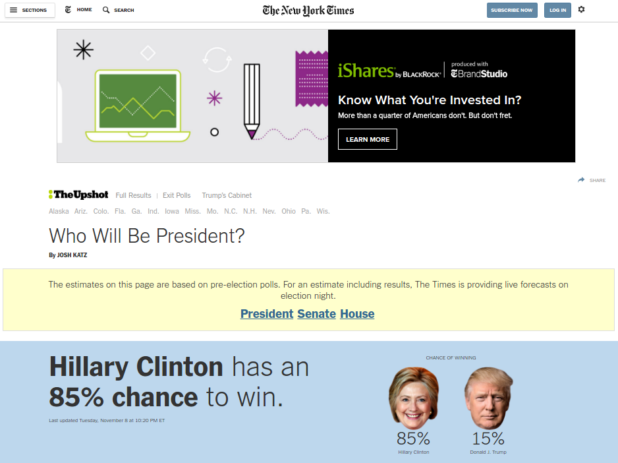
Hmmmm.
Does the headline match the article? Many compelling headlines don’t.
At time of writing, this story is on the front cover of the NYT.
The headline is “C.I.A. Judgment on Russia Built on Swell of Evidence.”
You would expect that the contents of the article would expound on what that evidence is, or at least give a firm, sourced statement that this evidence exists.
Instead, we get this:
The C.I.A.’s conclusion does not appear to be the product of specific new intelligence obtained since the election, several American officials, including some who had read the agency’s briefing, said on Sunday. Rather, it was an analysis of what many believe is overwhelming circumstantial evidence — evidence that others feel does not support firm judgments — that the Russians put a thumb on the scale for Mr. Trump, and got their desired outcome.
The article only talks about “circumstantial evidence” and the reasoning that the Russians liked Trump better, so of course they would interfere to support him. No discussion of actual forensics evidence or captured Russian operatives or anything else.
In other words, the article doesn’t deliver on the headline.
Strike two!
Does the article match the news story it’s lifted from? Many sites rewrite other news articles to fit the political slant of their presumed audience. Look for links to original sources and click through and see what the original says.
Let’s see here.

The NYT reported on this haji groping scenario a little while back. They obviously had to learn of this story from the Swedish press.
And as we reported, they deliberately obscured the ethnic origin of the culprits in order to push their political agenda.
Strike three!
Are quotes in context? Look for the sentences before and after the quote that makes your blood boil. If the article fails to give them, that’s a warning sign.
Now, the NYT is a professional news organization. Surely, they wouldn’t misquote people, right?
Is the story set in the future? It’s hard to get firsthand reporting from there. Any story that tells you what will happen should be marked down 50 percent for this reason alone.
That’s a tough one, as I think everyone likes to make predictions.
And so does the NYT.
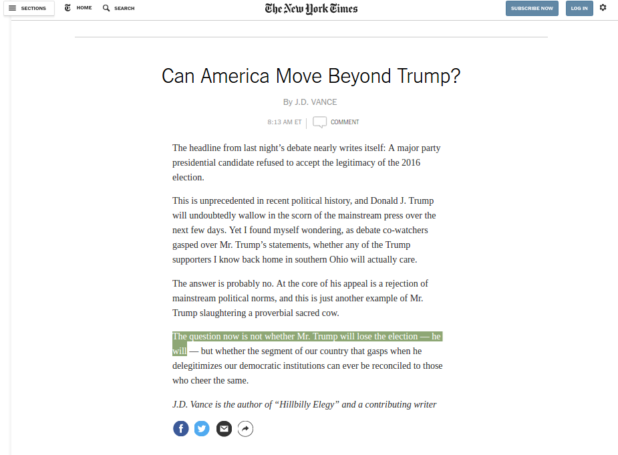
That was a pretty bold prediction. Too bad it didn’t come true, huh?
Does the story attack a generic enemy? Vague denunciations of “Washington” or “the media” or “Trump supporters” or “the left” should be marked down 99 percent. Good reporting doesn’t make these kinds of generalizations and is specific about who is making a claim about what.
That’s an easy one. They attack us all the time. For example:
Mr. Trump’s success is bound to embolden other dissenters. This could mean a political climate in which reservations about such multiculturalist policies as affirmative action are voiced more strenuously. It could mean a rise in racial conflict and a platform for alarming movements like Mr. Spencer’s. More likely, it is going to bring a hard-to-interpret mix of those things.

“These evil White supremacists are going to lead the country into a race war!”
This is almost too easy.
Are you asked to rely on one killer factoid? Not a good idea. If a hacked document “proves” an implausible conspiracy, look for the context that shows what the document really means. As for photos and video, use Ronald Reagan’s old slogan: trust but verify. If there’s any doubt about a “stunning” video, see if more traditional sources link to it. They love video clicks as much as anyone. If they refrain, there may be good reason.
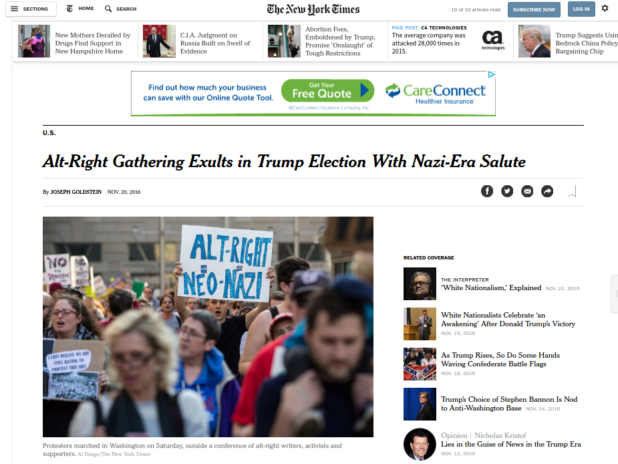
“Ah-ha! See? This one video clip proves the Alt-Right is a neo-Nazi movement!”
Now, we know that alt-right really is a neo-Nazi movement. But Spencer likes to play coy, and denies it, as do people like Jared Taylor and Peter Brimelow. That doesn’t prevent the NYT from using one small event to justify labeling these people as Nazis.
How many strikes is that now? I’ve lost count.
Who is the news source, anyway? Traditional news brands may occasionally get it wrong — sometimes hugely wrong — but at least you know where to find them and hold them accountable. Less prominent news sites might carry compelling stories — but expect them to show you who they are and where they gathered information.
Yeah, who is behind the New York Times, anyway?
Must be good old boys from New York, right?
Wrong.
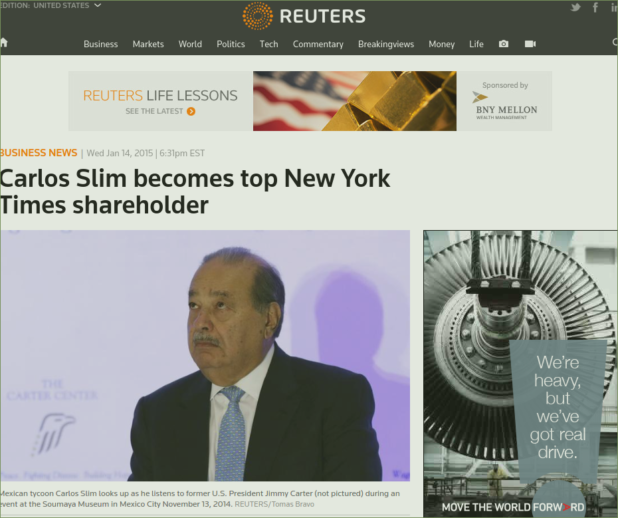
Oh.
It’s owned and thus controlled by a foreign billionaire with vast economic and political interests. And considering that it’s not exactly a profitable operation, we can only assume that he purchased it to control the spread of information sensitive to those interests.
Not exactly what I’d call a reliable source.
Does the news source appear to employ editors? Many news organizations produce stories that are checked before publication. Others don’t. It’s a big deal. Hiring an editorial staff shows the publication’s respect for you, and matters more than “political bias.” The New York Times and the Wall Street Journal, for example, have different owners, audiences, stories, perspectives and obsessions. Both have made mistakes and omissions; but both send reporters out into the world and back them up with an editorial process that catches and corrects many errors. This means both can be informative, regardless of your politics or theirs.
They obviously employ editors. But as seen above, they have been known to deliberately allow falsehoods or misrepresentation.
Also, as we’ve recently covered, this same editorial team has censored previously published real news because it didn’t fit with their political narrative.
Are you told, “Trust me”? Don’t. It’s the post-trust era! Expect everyone to show where their facts come from, link to underlying articles, and demonstrate that they’ve argued honestly.
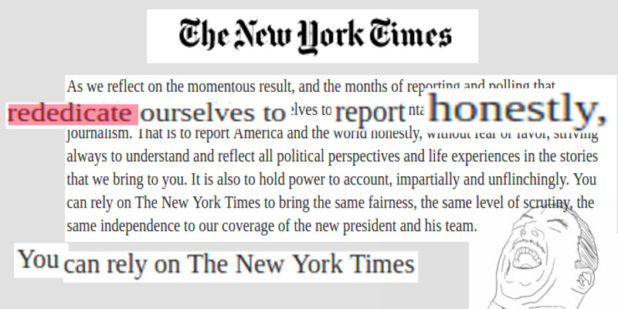
Did the writer engage with anyone who disagrees? Did they call a senator whose legislation bugs them? Did they try to grasp what the president-elect was doing, or merely repeat one of his more outrageous statements? If it’s a broadcast interview, was the guest presented with genuine opposing views and challenged to answer? Those who wrestle with opposing arguments do you a service and often improve their own arguments.
Well, to be fair, I’m sure they’ve done so a few times in their history.
But just looking at their coverage of their political enemies in this last year, obviously they haven’t exactly been engaging in a constructive dialogue with Trump or the Alt-Right.
And so, what is our final verdict?

Is the NYT a vulgar purveyor of fake news?
It seems that by the helpful and serious criteria set forth by NPR (a publicly funded organization), the New York Times falls squarely into the category of a “fake news” outlet.
And considering that it’s owned by a Mexican, they probably qualify as a foreign organization trying to influence American policy.
Thus, there’s no doubt that the government needs to shut them down as soon as possible, and put their staff on trial for treason.
